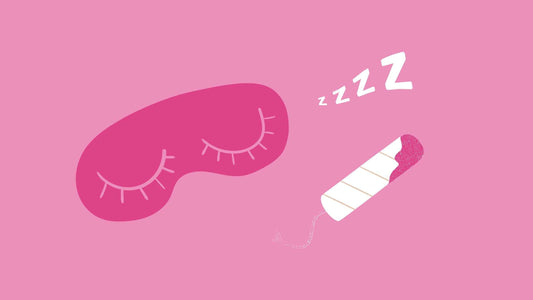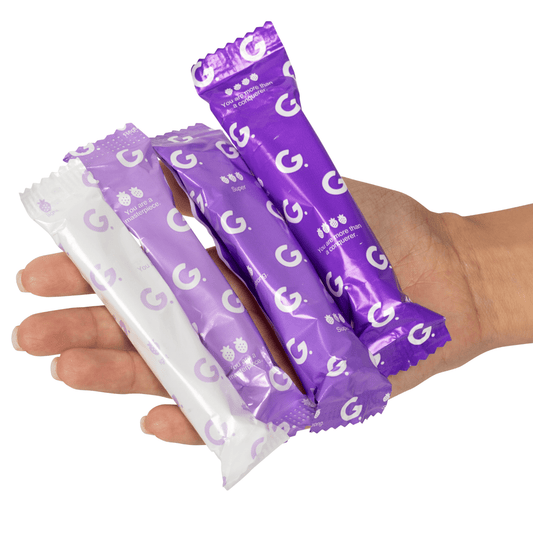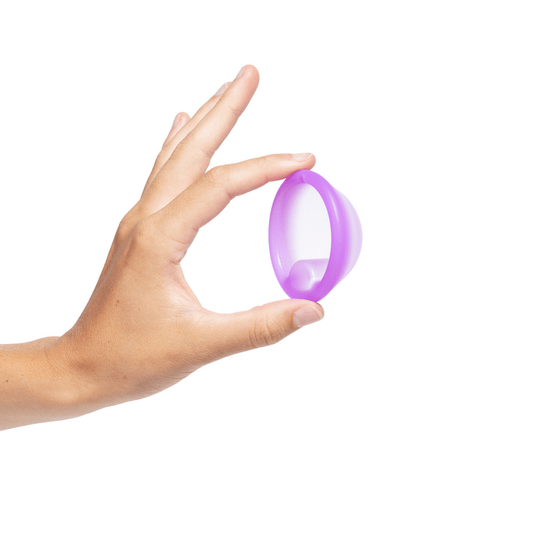
What is Ovulation Pain?
Share
Ovulation pain is one of the most agonizing symptoms that ovulating women experience. Many ovulating women feel an ovulation pain when they are ovulating, but not all ovulaters will experience ovulation pain. What is ovulation pain? This article will explore what causes this uncomfortable symptom and how to manage it!
What is ovulation?
To begin, let's cover the basics. There are 4 phases that make up the menstrual cycle. Those phases include menstruation (your period), the follicular phase, ovulation, and the luteal phase. A woman's menstrual cycle is typically 28 days long (this number varies from woman to woman), and ovulation occurs about halfway through the cycle on day 14. Read more on the menstrual cycle here.

Ovulation is when the ovary releases an egg that travels down the fallopian tube (refer to above diagram) headed for the uterus. This egg will eventually enter the uterus to be fertilized by sperm, or to be released during menstruation, but the egg can only be fertilized for about 12-24 hours after ovulation. Ovulation is the point in time women can conceive children. Read more on ovulation here.
What is ovulation pain?
For most women, ovulation is painless. However, some women experience painful ovulation where they may feel sharp pains on one side of their lower abdomen when they ovulate. The reason it is only painful on one side is because your ovaries take turns releasing an egg every month, so ovulation pain may switch sides every month.
Ovulation pain is caused by the ovary releasing the egg. The egg bursts through the ovary wall, and as it does so, it can cause a sharp pain on one side of your lower abdomen. This ovulation pain typically lasts for a few minutes to a few hours. For most women, the ovulation process goes unnoticed, but some women experience painful ovulation.
FUN FACT: Ovulation pain is also known as Mittelschmerz, which is a German word for "middle pain."
Symptoms of ovulation pain
Some symptoms of ovulation pain include:
- Bloating
- Dull, throbbing pain in the lower abdomen or pelvis
- Diarrhea
- Lightheadedness or dizziness
- Lower abdominal pain
- Nausea
- Pain on one side of the body
- Pain that lasts for a few minutes to a few hours
- Pelvic pain
- Vaginal bleeding
- Vomiting
- Mild to severe pain in the stomach area
- Sharp and sudden twinges
These symptoms can be observed at different intensities from period to period and may range in severity from woman to woman.
What causes ovulation pain?
The cause of ovulation pain is not completely understood, but it is thought to be related to the release of the egg from the ovary. When the egg is released, it may cause inflammation or irritation of the ovary.
The egg bursts through the ovary wall into the fallopian tube, and as it does so, it can cause a sharp pain on one side of your lower abdomen.
It is also thought that when there is an emerging follicle, the stretching of the ovarian membrane can create irritation. When a mature egg bursts from the follicle, you may experience bleeding as well.
These causes are suspected to lead to pain in the lower abdomen or pelvic region, and/or cause mild cramping.
1 in 3 women feel pain around the time an egg is released from the ovary.
Ovulation pain affects up to one-third of ovulating women. Whether it's a quick dull pain that lasts seconds to minutes, or it's sharp pain that lasts for hours, ovulation pain is more common than most think! It is most common in women between the ages of 20 and 24.
How do I treat ovulation pain?
There is no official treatment recommendation for ovulation pain. For almost everyone, their pain is not painful enough or too short in duration to bother treating.
If your pain is severe, consult a medical professional for testing and opinions.
How do I manage ovulation pain?
Ovulation pain is usually benign, meaning it is not a sign of a serious underlying condition. However, some experience severe ovulation pain or ovulation pain that lasts for long periods of time.
There are a few things you can do to help ease ovulation pain:
Tracking when the pain occurs to see if it is consistent every month is a great way to see if the pain is "normal" for your body. If the pain is irregular and changes in severity every month, consider getting it checked out! Tracking you ovulation pain is also helpful so that you know when to expect it.
Cold compresses or baths can help soothe muscle soreness.
Over-the-counter pain medication can also be taken to help with ovulation pain. Try Ibuprofen, Advil, Tylenol, etc.
Some other simple tricks to rid of the pain include applying a heating pad to the area of pain, resting and relaxing, avoiding strenuous activity, or taking a hot bath or shower.
The good news is that ovulation pain is generally harmless with the exception of extreme cases. When pain goes from mild to severe, lasts for more than a few days, or is accompanied by other symptoms such as fever, chills, or vomiting, medical intervention is suggested.
Can ovulation pain predict the timing of ovulation?
In recent years, ovulation pain in women has risen to its all-time high in recorded history. Though this is something that is being studied further, ovulation pain can be used to detect the timing of ovarian contractions, which is a telling signal that ovulation is near. Because becoming pregnant can only happen during ovulation (except for rare cases), this uncomfortable pain can be used for good!
So, yes! Ovulation pain can predict the timing of ovulation. If you are ovulating and trying to get pregnant, ovulation pain can be a good predictor of when you should have sex. If you feel ovulation pain, that means ovulation is likely within the next 12-24 hours. This is the optimal time to have sex if you are wanting to get pregnant!
Other causes of pain in the general area of your ovaries
Appendicitis, ectopic pregnancy, sexually transmitted infections, or complications with an ovarian cyst all have similar symptoms as ovulation pain but tend to be more severe and unexpected.
Constant pelvic pain could be a sign of vascular condition or an infection like pelvic inflammation disease and endometriosis. Ovarian cysts can grow large and can rupture. Ovarian cysts are not uncommon and can be caused by some types of hormonal birth control such as hormonal IUDs or some obstetric birth restrictions which stop ovulation. Talk to your doctor if you have persistent abdominal pain.
When to get further examination
When the ovulation pain you are experiencing exceeds a level you can handle, getting help is necessary. Though ovulation pain is generally harmless, there could be a more complicated underlying medical condition that is causing severe pain.
So, Garnuu Girls- There you have it! Everything you need to know about ovulation pain. We hope this article was helpful in answering any questions you have about ovulation pain.
XOXO,
The Garnuu Team
DISCLAIMER: This content was written for informational purposes to educate women only. It is not medical advice.








